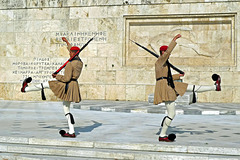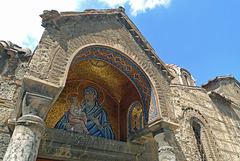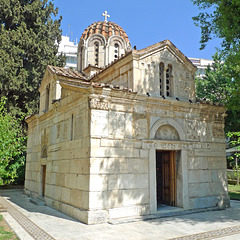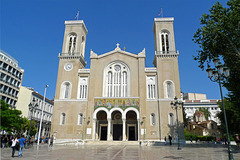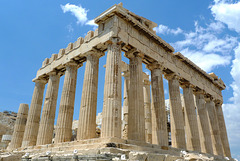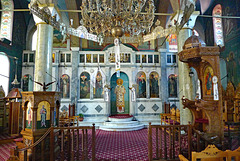Jaap van 't Veen's photos
Greece - Athens, changing the guard
| |
|
|
|
Greek guards or “Evzones” - also known as “Tsoliades” - are members of the Presidential Guard found outside the Hellenic Parliament. They have become synonymous with the city of Athens and were originally founded in 1868 as a regiment of the Greek army. It is a high honour for a soldier to be selected to join the “Evzones”.
They guard the grave of the Unknown Soldier that represents the common memory of all unknown soldiers killed at war. The changing of the Greek guards occurs every day at the top of the hour.
The “Evzones” are required to stand guard mute and expressionless for 60 minutes at a time, and are harshly punished if they succumb to the tantalizing efforts of tourists from all over the world to break their concentration.
Greece - Athens, Church of Panagia Kapnikarea
| |
|
|
|
The Church of Panagia Kapnikarea (Εκκλησία της Παναγίας Καπνικαρέας) is one of the oldest churches in Athens. It is located on the heart of the cty along an important shopping street. In 1834, after Greece had regained its independence and Athens, as the new capital, was in the midst of rebuilding, town planners had resolved to either demolish or relocate the church to ensure a thoroughfare for horse and carriages. The church had caught the eye of King Louis of Bavaria (father of the newly appointed King Otto of Greece) as an important landmark and together with the Metropolitan Bishop of Athens, ensured the street was designed with the church in place.
The church of Panagia Kapnikarea is a small Byzantine church dating from the 11th century. It was erected on an old church of the 5th century, itself built on a Greek temple. The church now belongs to the University of Athens and is also d "Church of the Sacred University".
The church’s name is linked with the family name “Kapnikares” and refers to the official charged with collecting tax on tobacco during the Byzantine period. It was formerly known as “Kamoucharea” from the word “kamoucha”, which means fabrics that are interwoven with gold, referencing the many textile workshops in the area.
Greece - Athens, Anafiotika
| |
|
|
|
The history of the charming neighbourhood of Anafiotika goes back to the mid-1800s. Greece needed workers to transform the new capital. Carpenters and masons from the island of Anafi (and other areas) came and took over this rocky terrain. They took advantage of the Ottoman law that stated a property belonged to you if you could build it between sunset and sunrise.
Anafiotika is a gem island-like oasis. Perched on the back of the Acropolis, the Anafiotika neighbourhood offers narrow, winding, shady streets with flowers and cats and views of the city. The narrow streets are lines streets with small white-washed osland-style houses. It looks like a village lost in time, filled with bougainvillaea, jasmine and other plants.
Greece - Athens, Little Metropolis Church
| |
|
|
|
The Little Metropolis (Μικρή Μητρόπολη), formally the Church of St. Eleutherios (Άγιος Ελευθέριος) is a Byzantine church located next to the large Metropolitan Cathedral of Athens ("Great Metropolis") .
The Little Metropolis Church - measuring just seven by eleven meters - is one of the smallest churches in Athens, but is also considered one of the oldest and most beautiful. It was built on an old temple - most probably in the early 13th century - and was mainly used for intercessions by pregnant women. Before the Great Metropolis Church was built, it was even a bishop's church.
Greece - Athens, Metropolitan Cathedral of the Ann…
| |
|
|
|
The Metropolitan Cathedral of the Annunciation (Καθεδρικός Ναός Ευαγγελισμού της Θεοτόκου), popularly known as the Great Metropolis is the cathedral church of the Archbishopric of Athens and all of Greece.
On Christmas Day, 1842 Greek King Otto and Queen Amalia laid the the first cornerstone of the Metropolitan Cathedral of Athens and thus commenced its construction. Workers used marble from 72 demolished churches to build the cathedral's immense walls. Three architects and 20 years later, it was completed. On May 21, 1862, the cathedral was dedicated to the Annunciation of the Mother of God.
The cathedral is a three-aisled, domed basilica that measures 40 meters long, 20 meters wide and 24 meters high. It features two bell towers and an impressive dome. The interior of the church is decorated with numerous frescoes; the impressive iconostase dates from 1825.Inside are the tombs of two saints killed by the Ottoman Turks during the Ottoman period: Saint Philothei and Patriarch Gregory V.
The Cathedral is a significant landmark in the Greek Orthodox Church and remains the largest church in Athens. Today it is the main church in Athens and also serves as the archbishop's seat.
Greece - Glyfada, Cathedral of Saints Constantine…
| |
|
|
|
The cathedral was built in 1934 and is the only one in Greece with a ‘rotunda dome’ and four semi-domes. Some years ago the temple was renovated and the paintings were replaced with mosaics. Nowadays the church is one of the most beautiful and majestic in the country.
Greece - Athens, Acropolis > Parthenon
| |
|
|
|
The Acropolis of Athens, or the “Sacred Rock” as it is called, is considered the ultimate symbol of ancient Greek civilization and culture. The Acropolis rock -156 meters above sea level - is considered a landmark for Athens, with its history linked to religious festivals, myths and struggles throughout the centuries. Since 1987 it has been a monument protected by UNESCO as a cultural site.
The Parthenon is the most characteristic and famous monument of the Acropolis. It was built on the ruins of a former temple in 447 BC, as part of a plan to rebuild the temples of the Acropolis after their destruction by the Persians in 480 BC. The construction of the building was completed in 438 BC, while the last decorative statues were added in 432 BC.
The Parthenon, built in honor of the goddess Athena, is 70 meters long (17 columns), 31 meters wide (8 columns) and 19 meters high. Its style is Doric, but also shows elements of Ionic style.as shown in the frieze. The material used for its construction is marble from Mount Pentelikon.
Greece - Athens, Acropolis > Erechtheion
| |
|
|
|
The Acropolis of Athens, or the “Sacred Rock” as it is called, is considered the ultimate symbol of ancient Greek civilization and culture. The Acropolis rock -156 meters above sea level - is considered a landmark for Athens, with its history linked to religious festivals, myths and struggles throughout the centuries. Since 1987 it has been a monument protected by UNESCO as a cultural site.
The Erechtheion (or Temple of Athena Polias), located on the northern side of the Acropolis, was built between 421 and 406 B.C., but was actually completed in 395 B.C., due to interruptions caused by the Peloponnese Wars. It is a replacement of an earlier temple dedicated to Athena Polias. The name derives from Erechtheus, the mytical king of Athens, who was worshipped there.
The Erechtheion consists of several sacred sites, all under one roof. These include a church, a palace and a harem. This structure has a rather complicated layout when compared to others on the Acropolis. There are shrines inside dedicated to Athena and Poseidon, who fought for the city, as well as to the two legendary Kings of Athens, Erechtheos and Kekrops.
The Erechtheion is known mainly through its porch, its colums instead of pillars had six maidens - two meters in height - known as the “Caryatids”, that support the roof. In 1811 one of them was brought to England (now in the British Museum); the remaining five were replaced by replicas to prevent further damage from the smog (nowadays the originals are in the Acropolis Museum).
Greece - Karpenisi, Holy Church of the Virgin Mary
| |
|
|
|
The Holy Church of the Virgin Mary (Ιερός Ναός της Παναγίας) is one of the five large churches in the the town of Karpenisi. The Virgin Mary Church was the cathedral during the Turkish occupation. In July 1821 all churches were destroyed and/or burned down.
After the burning of the churches and the whole town of Karpenisi by the Turks in 1821, the people began to settle down again. Their primary goal was to rebuild their churches and school. Each parish was interested in its own hurch and was doing an enviable activity. The present Holy Church of the Virgin Mary was built in 1910 and it is the fourth time that the church has been built on the same site.
Greece - Preveza, Metropolitan church of Saint Cha…
| |
|
|
|
The Metropolitan church of Saint Charalambos (Agios Charalambos) was built between 1715 and 1717 - when Preveza was still under Ottoman occupation - on the location of an older church. It is built in the style of a single-space basilica, but the later interventions and additions have changed its initial shape. On the eastern side they have walled-in a Roman sarcophagus from Nicopolis, in order to be used as a fountain. On the south-eastern side of the church, a later dated tower-shaped bell tower has also been added.
The painted decorations of the temple include great oil-paintings which cover the side walls and the wooden roof. These paintings are copies of religious works of art by great European artists. Of exceptional quality is the wooden-carved iconostasis of the church, which was constructed by a craftsman from Epirus in 1827 and was gold-plated in 1836. The pulpit, the archieratic throne and some of the portable icons are also of great artistic value.
The church is located - a little bit hidden by the Venetian tower - at the pedestrian zone of the historical center of Preveza (PiP3).
Greece - Lefkada, Faneromeni Monastery
| |
|
|
|
Faneromeni Monastery - the most important religious center on the island of Lefkada - was built in 1634 on the site of an ancient temple dedicated to Artemis, the goddess of hunt, forests and animas. On this site, the students of Apostle Paul had preached Christianity some centuries ago.
In the Venetian times, particularly in the 18th century, the monastery was renovated, but unfortunately, two fires burnt it down. In the late 19th century the monastery was rebuolt in its current state. Today, it hosts an interesting Ecclesiastical Museum with rare Byzantine icons, paintings, carvings, handwritten manuscripts and other religious relics.
The monastery is located on a hill above the town of Lefkada and offers great views to the village and the northern side of the island PiP5).
Greece - Platamon Castle
| |
|
|
|
Platamon Castle is dating back to the middle Byzantine period (10th century AD). It is situated at the location of the ancient city of Heraclia. The name “Platamon” appears for the first time in an imperial order of 1198 but, most probably, there was already a Byzantine castle there, since the 10th century.
Following the fall of Constantinople during the 4th Crusade in 1204, Lombardian crusaders took over the land and built a castle on top of the remains of the old structure. The castle functioned as a strategic lookout point over the passage between Macedonia and southern Greece. Despite their efforts to retain control of the castle, it wasn’t long before the Byzantines took it over again. In 1218, the Komnenos, a Byzantine noble family, established dominion over the castle.
The Turks captured the castle in 1385 and paid much attention to its maintenance because they needed the castle to control the strategically important area. After a short break between 1425 and 1427, when the Venetians managed to conquer the castle, the Turks returned and stayed until the beginning of the 20th century.
During World War II, in April 1941, a unit of New Zealanders tried to defend Platamon but were forced to leave after the bombardment of the castle by the Germans.
The Castle of Platamon is located southeast of Mount Olympus near the village of Platamon. The landmark of the castle is the well-preserved octagonal tower with a height of 16 meters.
Greece - Milies, Church of Taxiarches
| |
|
|
|
The Church of Taxiarches is located in the central aquare of Mlilies, one of the quaint Pelion villages. From an architectural point of view the church has very simple exterior, which does not remind of any temple at all, since during the Turkish occupation the construction of majestic orthodox Christian buildings was avoided, so as not to provoke the Turks.
It is unknown when exactly this church was built, but a sign at the entrance tells that it was renovated in 1741. The interior of the Church of Taxiarches is stunningly beautiful and impresses visitors with the wall paintings that depict scenes from the Bible and Hell. Of exceptional, but also unique interest is the icon painting, which was probably done by an unknown monk, while the gilded iconostasis was made by Epirote craftsmen.
The Church of Taxiarches is an important historical monument for Pelion as in May 1821, the scholar Anthimos Gazis raised the Greek flag and proclaimed the revolution in Thessaly. .
Greece - Tsgarada, plane tree
| |
|
|
|
The plane tree in Tsagarada is one of the oldest trees in Europe. It is located in the square of Tsagarada in front of the Agia Paraskevi (PiP4).
According to foresters, the tree is around 1000 years old. The circumference of the trunk measures over 15 meters. The crown of the plane tree is so large that it is difficult to measure it. Its perimeter may even be 40 meters. The branches are as thick as a tree trunk. The general condition of the tree is very good. However, the trunk has a cavity which is closed with a metal sheet. One of the branches is supported by a marble pillar.
What might have not been taken into account for the age of the tree is that its roots start at about four meters under the paving of the square. Therefore, a large part of the trunk is “buried” for many years now at a depth of at least four meters.
Greece - Volos, Saint Nicholas Orthodox Metropolit…
| |
|
|
|
The pericircular - Byzantine dome - Metropolitan Church of St. Nicholas of Volos was built on the initiative of the respective Mayors and Municipal Councils of the city. It was founded in 1928 and inaugurated at the end of 1934 by the then Metropolitan of Demetrias Germanos.
The church is the work of the architect Aristotle Zachos and is built on the foundations of an older church that was burned down in1898. The unique art of the baroque style bell tower was built between 1886 - 1890 by Italian craftsmen. It was severely damaged by the 1980 earthquakes and was restored as a listed monument with the same marble in 1999.
Greece - Omorfokklesia, Church of Agios Georgios
| |
|
|
|
The Church of Agios Georgios (Saint George) is located 20km southwest of the city of Kastoria, in the mountainous village Omorfokklesia. The church is one of the most popular Byzantine monuments of Macedonia. From this church the village also took its name, which was initially called Kallista or Ghalista (“kallisti” in Greek means “the most beautiful”).
The cruciform church with a narthex is estimated to be built in 11th century. Its interior decoration has plenty frescoes dated in 13th century whereas its exterior frescoes are dated in the early of 14th century. The Church of Agios Georgios is most known for its wooden statue of St. George – wearing the traditional greek skirt “foustanella” – dating back to the 13th century. This oversized historical and cultural value picture is about 3 meters tall and is considered miraculous (PiP5).
According to tradition some nuns were trying to carry this sculpture with a stretcher from Konstantinoupolis. As they were passing by the place that the church is nowadays located the stretcher stopped moving against their willing. Then the nuns thought it was St. George’s desire to be there and they decided to built a church to honor his name. Every year thousands of believers visit the church during St. George’s celebration day to pray and stick their coin on the glyph. Once the coin sticks means that the believer has a strong faith and his/her prayers may come true.
Greece - Monastery of Prousos, katholicon
| |
|
|
|
The Monastery of Panagia Prousiotissa (the Virgin Mary of Prousos) is dedicated to the Dormition of the Virgin and is one of the most important religious locations in Greece. According to tradition, the icon (PiP1) was painted by St. Luke the Evangelist in Prousa (nowadays Turkish Bursa) during the reign of the iconoclast emperor Theophilus. It was taken away from there to be saved from the burning of the icons the emperor had ordered. The icon was brought to Greece by a young man of noble origin, called Dionysios, but for an unknown reason the icon was lost when Dionysios arrived in Thrace.
This holy site dates back to 829AD and is linked to the adventures and the appearance of the holy icon in a cave of this area. The monastery was founded at the exact place which the Virgin Mary chose in a miraculous way. The miraculous icon of Panagia Proutiotissa is now kept in a carved cave church, the first church of the monastery. The katholikon is a cross-shaped temple with a dome. It dates back to 1754 and is also decorated with murals.
The icon was found on the 23rd of August which is also the date that the church celebrates. Monastery of Prousos is attracting many faithful each year, who come here to venerate the famous and miraculous icon of the Virgin Mary.
Greece - Monastery of Prousos
| |
|
|
|
The Monastery of Prousos (Monastery of Panagia Prousiotissa = Virgin Mary of Prousos) is built in beautiful surroundings on a steep rock and above the deep canyon of the river Karpenisiotis . According to the tradition, it was founded in 829 by monks Dionysios and Timotheos, who brought with them the icon of Virgin Mary from Prousa in Asia Minor. However, it is more possible that the monastery was established between the 12th and 14th century.
The monastery has a main building where Virgin Mary Prousiotissa is worshiped and a part where the cells of ther monks are located. A small museum is housed in the monastery with several exhibits such as icons dating back to the 15th and 16th century, sacred vestments, silver and golden chalices and handwritten codes and typography books.
During the War of Independence against the Turks, it was a refuge for Greek rebels. In August 1944 German troops burnt down a large part of the monastery, destroying many relics, handscripts, books and items of everyday use. The monastery has been rebuilt several times.
Jump to top
- ipernity © 2007-2024
- Help & Contact
|
Club news
|
About ipernity
|
History |
ipernity Club & Prices |
Guide of good conduct
Donate | Group guidelines | Privacy policy | Terms of use | Statutes | In memoria -
Facebook
Twitter

